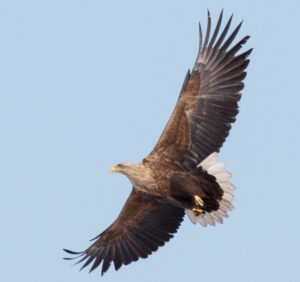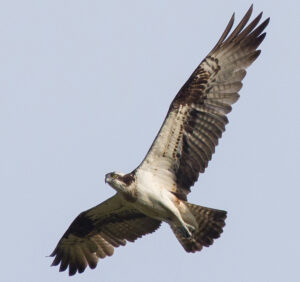Third International Scientific and Practical Conference “Eagles of the Palearctic: Study and Conservation”
Raptors Conservation. Suppl. 2. Proceedings of Conferences
LARGE RAPTORS IN “NURGUSH” STATE NATURE RESERVE, KIROV REGION, RUSSIA
Bakka S.V. (Nurgush State Nature Reserve, Kirov, Russia)
Kiseleva N.Yu. (Minin Nizhny Novgorod State Pedagogical University, Nizhny Novgorod, Russia)
Kondruhova S.V. (Nurgush State Nature Reserve, Kirov, Russia)
Contact:
Sergei Bakka sopr_nn@mail.ru
Nadezhda Kiseleva sopr@dront.ru
Svetlana Kondruhova parus1970@mail.ru
Recommended citation: Bakka S.V., Kiseleva N.Yu., Kondruhova S.V. Large raptors in “Nurgush” State Nature Reserve, Kirov region, Russia. – Raptors Conservation. 2023. S2: 121–125. DOI: 10.19074/1814-8654-2023-2-121-125 URL: http://rrrcn.ru/en/archives/34917
In this report, we explored the nature of stay and the number of large raptors in “Nurgush” State Nature Reserve in Kirov region, assessed the role of the reserve in conservation of these birds.
The Nature reserve consists of two sections. The “Nurgush” section that was created in 1994 (protected area – 5634.2 ha, buffer zone – 7942.4 ha) preserves a fragment of the primary vegetation in the southern boreal floodplain of the Vyatka River in the Kotelnichsky district. The “Tulashor” section (protected area 17815.5 ha, buffer zone – 17566.1 ha) was created in 2010 to protect intact middle taiga forests in the Nagorsky district.
Four large raptor species listed in the Red Book of Russia have been recorded in the reserve: Osprey (Pandion haliaetus), White-Tailed Eagle (Haliaeetus albicilla), Greater Spotted Eagle (Aquila clanga), Golden Eagle (Aquila chrysaetos).
Osprey is a rare migratory species, possibly nesting in the vicinity of “Nurgush” section. On migration and during the breeding period it is encountered near the Vyatka River, lakes Staritsa, Nurgush, Holchovik, the Prost’ River. According to A.D. Fokin (1960), Osprey was regularly encountered on large lakes of Nurgush Reserve before. The waters of the Nature Reserve are used as a feeding station. Osprey is supposed to nest on the left bank of Vyatka River. During migration and breeding season, individual birds, pairs, and rarely groups of 3–4 individuals are found here, its abundance is estimated at 0.7 pairs/100 km2. It arrives in spring in the second–third decade of April, the earliest encounter noted on August 4, 2004. On autumn migration it is encountered between the first decade of September and the second–third decade of October, the latest date is October 24, 2007.
There are no habitats suitable for Osprey in the “Tulashor” section.
White-Tailed Sea Eagle is a common nesting species, in some years staying to winter in the “Nurgush” section. It is more often observed nesting on the lakes: Nurgush, Krivoe, Small Krivoe, Holchovik; in Kaleichi and Prudishcha tracts; on the river Vyatka. In spring and autumn, it is much more common. In the last decade, winter encounters have become more frequent as birds stay on channels and rivers near beaver dams and on lakes near non-freezing polynyas. Occupied WhiteTailed Eagle nest is located on the territory of the Natural Reserve near Lake Nurgush. This nest has been known since the 1950s. Another nest has been located on the left bank of the Vyatka River, on Lake Myandy near the village of Vishkil. Species abundance is estimated at two pairs/100 km2. Analysis of species registration sites in Nature Reserve in 2016– 2022 using GIS-method allows us to suggest that there are 5–6 breeding territories in the Nature Reserve, buffer zone and its immediate vicinity.
Greater Spotted Eagle is a rare migratory species nesting in both sections of the Nature Reserve. In the “Nurgush” section it is found in protected area, the buffer zone, and the surroundings. In the summer, individual birds were recorded in Kaleichi and Okunki tracts, on lakes Mezhnoe and Dolgoe. In 2015 and 2016 Greater Spotted Eagles nested on a platform in the buffer zone in Sosnovy Kust tract. Its abundance is estimated at 0.7 pairs/100 km2. In spring Greater Spotted Eagles appear in the second (April 11–17, 1998) and third (April 26, 1998) decades of April. In autumn it is encountered until the second decade of September (September 22, 2013).
In the “Tulashor” section Greater Spotted Eagle nests in the Fedorovka river valley. It is only recorded in its buffer zone and adjacent area. It nests on large pine trees in the upper slopes of taiga river valleys, preys mainly on water voles in river floodplains. A pair was observed on June 19, 2013, in Fedorovka river floodplain at the border of squares 49/39 of the buffer zone. An old nest located in the Fedorovka river floodplain terrace on a pine tree 300 m south of the Pozhmashor ranger station most likely belonged to the species. In 2016–2017 this nest was empty, and by 2018 almost completely broke down, the breeding territory disappeared. Adult individual was encountered on May 13, 2017, in the adjacent territory in the Fedorovka river floodplain, near the former village of Estapovo.
The total number of breeding territories in both sections of the reserve and their buffer zones is estimated at 3–5.
Golden Eagle is a very rare migratory species of the “Nurgush” Nature Reserve. In autumn, Golden Eagles were observed in Prudishcha tract (August 24, 2010), Molchalnik tract (September 20, 1995), Laptev mowing (September 10, 1996), Zakalye (October 19, 1999), Pishchalsky island (October 9, 1996), near the village of Borovka (November 12, 1997). Individual birds, rarely pairs, are found during post-nesting migrations in the first and second decades of October.
V.M. Ryabov (2013) includes the species in the faunistic list of “Tulashor” section based on data obtained before 2011 (prior to the Nature Reserve creation). We believe that Golden Eagle habitat in the “Tulashor” section and its buffer zone is impossible as there are no suitable habitats here. Individual birds only visit here occasionally.
“Nurgush” Nature Reserve plays an important role in conservation of White-Tailed Eagle and Greater Spotted Eagle in Kirov region. The role of the Nature Reserve in Osprey conservation is small.


